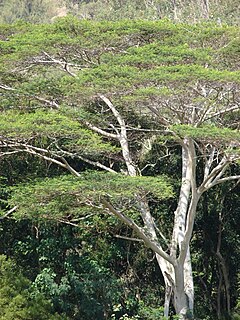
Albizia is a genus of more than 160 species of mostly fast-growing subtropical and tropical trees and shrubs in the subfamily Mimosoideae of the family Fabaceae. The genus is pantropical, occurring in Asia, Africa, Madagascar, America and Australia, but mostly in the Old World tropics. In some locations, some species are considered weeds.

Streptomyces is the largest genus of Actinomycetota and the type genus of the family Streptomycetaceae. Over 500 species of Streptomyces bacteria have been described. As with the other Actinomycetota, streptomycetes are gram-positive, and have genomes with high GC content. Found predominantly in soil and decaying vegetation, most streptomycetes produce spores, and are noted for their distinct "earthy" odor that results from production of a volatile metabolite, geosmin.
In botany, the correct name according to the International Code of Nomenclature for algae, fungi, and plants (ICN) is the one and only botanical name that is to be used for a particular taxon, when that taxon has a particular circumscription, position and rank. Determining whether a name is correct is a complex procedure. The name must be validly published, a process which is defined in no less than 16 Articles of the ICN. It must also be "legitimate", which imposes some further requirements. If there are two or more legitimate names for the same taxon, then the correct name is the one which has priority, i.e. it was published earliest, although names may be conserved if they have been very widely used. Validly published names other than the correct name are called synonyms. Since taxonomists may disagree as to the circumscription, position or rank of a taxon, there can be more than one correct name for a particular plant. These may also be called synonyms.

The Streptomycetaceae are a family of Actinomycetota, making up the monotypic order Streptomycetales. It includes the important genus Streptomyces. This was the original source of many antibiotics, namely streptomycin, the first antibiotic against tuberculosis.

Drepana falcataria, the pebble hook-tip, is a moth of the family Drepanidae. The species was first described by Carl Linnaeus in his 1758 10th edition of Systema Naturae. It is found in Europe, through Siberia to the eastern Palearctic.

Streptomyces griseus is a species of bacteria in the genus Streptomyces commonly found in soil. A few strains have been also reported from deep-sea sediments. It is a Gram-positive bacterium with high GC content. Along with most other streptomycetes, S. griseus strains are well known producers of antibiotics and other such commercially significant secondary metabolites. These strains are known to be producers of 32 different structural types of bioactive compounds. Streptomycin, the first antibiotic ever reported from a bacterium, comes from strains of S. griseus. Recently, the whole genome sequence of one of its strains had been completed.

Falcataria is a genus of flowering plants in the family Fabaceae. It belongs to the monophyletic Mimosoid clade in the subfamily Caesalpinioideae. The genus has three species previously classified in the Falcataria section of the genus Paraserianthes by I.C. Neilsen. The distribution of these closely related species within the genus Falcataria links the wet tropics of north-east Australia to New Guinea, the Moluccas, Bismarck Archipelago, and the Solomon Islands east of Wallace's line similar to other plant taxa from the region.

Falcataria falcata, commonly known as the Moluccan albizia, is a species of fast-growing tree in the family Fabaceae. It is native to the Maluku Islands, New Guinea, the Bismarck Archipelago, and the Solomon Islands. It is cultivated for timber throughout South Asian and Southeast Asian countries. This tree is considered to be invasive in Hawaii, American Samoa and several other island nations in the Pacific and Indian Oceans. It reaches about 30 m (100 ft) tall in nature, and has a massive trunk and an open crown.
Streptomyces abikoensis is a bacterium species from the genus Streptomyces which produces the antibiotic abikoviromycin. Streptomyces abikoensis has been isolated from Abiko in Japan.
Streptomyces asiaticus is a bacterium species from the genus Streptomyces which has been isolated from the ectorhizosphere from the plant Falcataria moluccana in Java on the island Yogyakarta in Indonesia.
Streptomyces castelarensis is a bacterium species from the genus of Streptomyces which has been isolated from dust in Castelar in Argentina. Streptomyces castelarensis produces camphomycin.
Streptomyces cinnamoneus is a bacterium species from the genus of Streptomyces which has been isolated from soil in Japan. Streptomyces cinnamoneus produces duramycin A, duramycin B, duramycin C, carbomycin, cinnomycin and fungichromin.
Streptomyces filamentosus is a bacterium species from the genus of Streptomyces which has been isolated from soil. Streptomyces filamentosus produces caryomycin. Streptomyces filamentosus also produces the novel cyclic lipopeptide antibiotic daptomycin.
Streptomyces hiroshimensis is a bacterium species from the genus of Streptomyces which has been isolated from soil. Streptomyces hiroshimensis produces the red pigment prodigiosin.
Streptomyces indonesiensis is a bacterium species from the genus of Streptomyces which has been isolated from the tree Paraserianthes falcataria from Yogyakarta on Java in Indonesia.
Streptomyces microflavus is a bacterium species from the genus of Streptomyces which has been isolated from soil. Streptomyces microflavus produces nemadectin, fattiviracin A1, milbemycin and deoxyuridines. Streptomyces microflavus also produces the ionophore valinomycin. Streptomyces microflavus is also known to cause potato common scab disease in Korea.
Streptomyces murinus is a bacterium species from the genus of Streptomyces which has been isolated from soil. Streptomyces murinus produces the actinomycin X complex and glucose isomerase Streptomyces murinus can be used for its production of glucose isomerase in the food industry. Streptomyces murinus produces lankamycin and lankacidin.
Streptomyces purpureus is a bacterium species from the genus of Streptomyces which has been isolated from soil. Streptomyces purpureus produces chloramphenicol, bottromycin and fradicin.
Streptomyces rhizosphaericus is a bacterium species from the genus of Streptomyces which has been isolated from the ectorhizosphere of the tree Paraserianthes falcataria from Yogyakarta on Java in Indonesia.
Streptomyces yogyakartensis is a bacterium species from the genus of Streptomyces which has been isolated from rhizosphere soil from the tree Paraserianthes falcataria in Yogyakarta on Java on Indonesia.




